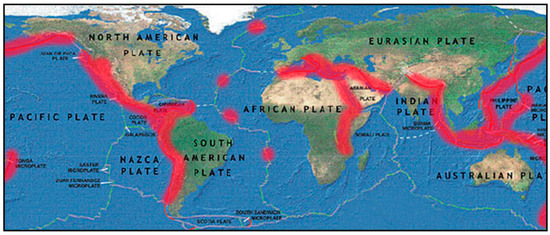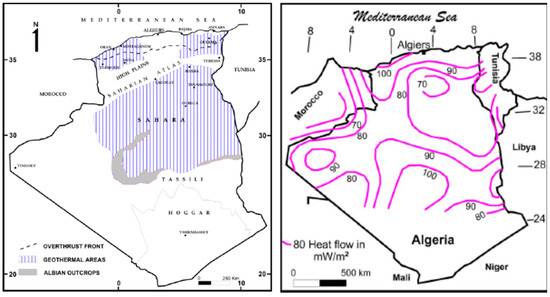Geothermal energy is one of the cleanest, most accessible and cheapest alternative energies in the whole world. It is a renewable energy designating an inexhaustible source at a human scale that can be renewed (energy culture). Geothermal energy comes from the disintegration of radioactive elements present in rocks and the Earth’s core. These generate heat flow to the surface. This heat increases with depth on average by 30 °C/km [1]. In Algeria, this gradient varies from 25 °C/km in the north to 60 °C/km in the south [2]. In 2006, Madlnés published a world map showing the geothermal potential on all continental plates. North Africa has geothermal potential, which explains why many geothermal studies have been carried out in the north of Algeria (Figure 1). Figure 2 shows the geothermal areas in Algeria where the reservoir rocks are the Jurassic limestone in the north and Albian sandstone in the south. This renewable energy is used in multiple areas: fish farming, greenhouse heating or district heat networks, balneotherapy, and electricity production. Currently, only a tiny fraction of the world’s geothermal resources are used. Certain technological improvements and a better recognition of the true value of geothermal energy could lead to a strong development of this clean and reliable energy for the majority of the countries of the world. Algeria, which has about 200 thermal springs, has the possibility of being among the leaders in this field. In this presentation, we cite the characteristics of geothermal energy, the Algerian thermal springs and the possibilities of their uses according to the temperatures using the Lindal diagram, as well as the role of geophysics or the Earth’s physics in the exploration of geothermal sources before drilling where most of the techniques are the same as those used in petroleum exploration and reservoir characterization exploiting new technological development such as artificial intelligence from seismic and well-logs data [3].

Figure 1.
Continental plates and high geothermal potential areas in red [4].

Figure 2.
Main Algerian geothermal areas [5], on the left side. Heat flow map of Algeria [2].
Author Contributions
Conceptualization, L.A. and S.-A.O.; methodology, L.A. and S.-A.O.; validation, S.-A.O.; formal analysis, S.-A.O.; investigation, L.A. and S.-A.O.; resources, L.A. and S.-A.O.; data curation, L.A. and S.-A.O.; writing—original draft preparation, L.A.; writing—review and editing, S.-A.O.; visualization, S.-A.O. All authors have read and agreed to the published version of the manuscript.
Funding
This research received no external funding.
Institutional Review Board Statement
Not applicable.
Informed Consent Statement
Not applicable.
Data Availability Statement
The data are public.
Conflicts of Interest
The authors declare no conflict of interest.
References
- Arndt, N. Geothermal Gradient. In Encyclopedia of Astrobiology; Gargaud, M., Amils, R., Quintanilla, J.C., Cleaves, H.J., Irvine, W.M., Pinti, D.L., Viso, M., Eds.; Springer: Berlin/Heidelberg, Germany, 2011. [Google Scholar] [CrossRef]
- Saibi, H. Geothermal resources in Algeria. Renew. Sustain. Energy Rev. 2009, 13, 2544–2552. [Google Scholar] [CrossRef]
- Aliouane, L.; Ouadfeul, S.; Djarfour, N.; Boudella, A. Petrophysical Parameters Estimation from Well-Logs Data Using Multilayer Perceptron and Radial Basis Function Neural Networks. In Neural Information Processing, Proceedings of the International Conference on Neural Information Processing, Doha, Qatar, 12–15 November 2012; Huang, T., Zeng, Z., Li, C., Leung, C.S., Eds.; Lecture Notes in Computer Science Series; Springer: Berlin/Heidelberg, Germany, 2012; Volume 7667. [Google Scholar]
- Mádl-Szőnyi, J. Geothermal Energy—Resources, Research, Utilization; Grafon Kiadó: Budapest, Hungary, 2006. (In Hungarian) [Google Scholar]
- Fekraoui, A.; Abouriche, M. Algeria country update report. In Proceedings of the World Geothermal Congress, Florence, Italy, 18–31 May 1995; International Geothermal Association: Auckland, New Zealand, 1995; pp. 31–34. [Google Scholar]
Disclaimer/Publisher’s Note: The statements, opinions and data contained in all publications are solely those of the individual author(s) and contributor(s) and not of MDPI and/or the editor(s). MDPI and/or the editor(s) disclaim responsibility for any injury to people or property resulting from any ideas, methods, instructions or products referred to in the content. |
© 2023 by the authors. Licensee MDPI, Basel, Switzerland. This article is an open access article distributed under the terms and conditions of the Creative Commons Attribution (CC BY) license (https://creativecommons.org/licenses/by/4.0/).